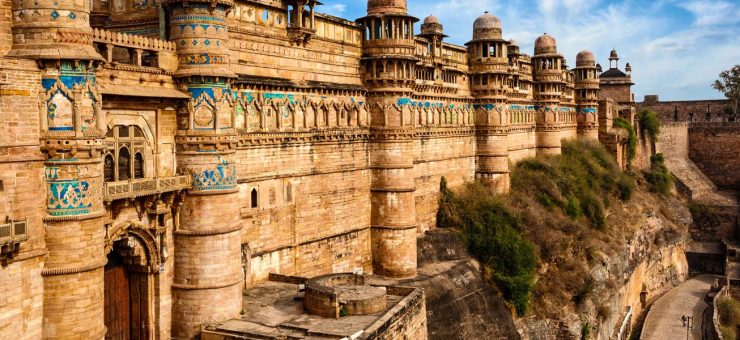Madhya Pradesh is famous throughout the world for the temples of Khajuraho built in the 10th and 11th centuries, which have internal and external walls embellished with exquisite stone carvings that portray every facet and mood of life, from the erotic to the divine, the commonplace to the sublime. A week-long Festival of Classical Dances is held at Khajuraho in February/March every year, during which India’s foremost exponents of dance perform against the spectacular backdrop of the floodlit temples.
However, the state has much more to offer than just Khajuraho. With almost a third of its area covered in forests, Madhya Pradesh boasts 11 national parks and 31 wildlife sanctuaries, including the Kanha National Park and Bandhavgarh National Park, which are Asia’s largest wildlife sanctuary and tiger reserve, respectively. These parks are home to a variety of wildlife, including panthers, Indian bison (gaur), and various deer species. In fact, together, they house one-sixth of the world’s tiger population. It is no wonder, then, that Madhya Pradesh proudly holds the title of the “Tiger State”.
Gwalior
Gwalior, in North Madhya Pradesh, is dominated by a massive hilltop fort, one of the finest examples of medieval architecture. Apart from several interesting monuments such as the beautiful Mansingh Palace (perched on the very edge of the fort), Teli Mandir, and the exquisitely carved Sas Bahu Temple (dedicated to ‘Sahasrabahu,’ ‘the thousand-armed’ Lord Vishnu), the fort also houses one of India’s leading public schools, The Scindia School, which celebrated its centenary in 1997.
The Durbar Hall of the 19th-century Jai Vilas Palace, the residence of the Scindia family (the former rulers) located in the city, boasts a pair of chandeliers reputed to be the largest in the world. Each chandelier measures 12.8 m in height and weighs 3 tonnes. Legend has it that before installing these chandeliers, the palace roof was tested by hoisting three elephants onto it! A section of the palace now serves as a museum showcasing family memorabilia. The highlight of the museum is a model railway that once carried cigars and brandy around the dining table.
Gwalior has a rich tradition of Hindustani classical music dating back to medieval times. Baiju Bawara, the composer-singer at the court of Raja Man Singh Tomar in the early 16th century, ‘Sangeet Samrat’ (king of music) Tansen, one of Mughal Emperor Akbar’s ‘nine jewels,’ and more recently, classical singer V.D. Paluskar and ‘sarod’ maestro Hafiz Ali Khan, all trace their roots to this city. The tomb of Tansen in Gwalior serves as the venue for an annual music festival. Furthermore, Hafiz Ali Khan’s son and celebrated disciple, Ustad Amjad Ali Khan, continues to captivate audiences worldwide with the enchanting melodies of his magical ‘sarod’.
Bhopal
Bhopal, the capital, is spread out on 7 gentle hills and around two pretty lakes. It is an amalgam of scenic beauty, evocative monuments (such as the Taj-ul-Masjid, one of the largest mosques in India, Jama Masjid and Moti Masjid), and contemporary buildings.
Just 40 km South, amidst rocky terrain and dense forest, lies the archaeological treasure Bhimbetka. The world’s largest group of rock shelters (nearly 700) belonging to the Neolithic age was found here recently. more than 500 of these shelters have pre-historic paintings on their walls depicting the lives of the cave dwellers-huge figures of bisons, tigers and rhinoceros, hunting scenes, communal dances, mother and child, honey collection and so on. And it has been found that the caves were used by different people over a long period of time from the Upper Palaeolithic to the Early Historic periods.
Sanchi, renowned for the oldest Buddhist stupa in the world, build by Emperor Ashoka (3rd century BC); Orchha, the capital city if the Bundela rulers (16th and 17th centuries), famous for its grand palaces and temples; Mandu, a fortress town strategically perched at the edge of the Malwa plateau and protected by massive 45 km long fort walls; Shivpuri, the summer capital of the former Scindia rulers; and Chanderi, famous for its fine sarees and brocades, are some of the other places where M.P.’s archaeological treasures are worth exploring.
The holy city, Ujjain, lies 188 km West of Bhopal on the banks of the Shipra River. It is one of the four cities in India where the Kumbh Mela is held every 3 years in rotation (each city getting its turn after 12 years). During the Mela, millions of Hindu devotees come for a purifying dip in the river. The city abounds in temples, and the spire of the Mahakaleshwar Temple ( dedicated to Lord Shiva) dominates its skyline.
Pachmarhi is a pretty hill station about 190 km South-East of Bhopal. Its cascading waterfalls, deep blue pools, ravines and a maze of gorges sculpted in red sandstone offer a quiet escape into nature.
Shopping in Madhya Pradesh
Maheshwari sarees are renowned for their novel weave, colors, patterns, and reversible borders. Chanderi sarees and brocades are also highly regarded. Additionally, the state is known for finely ornamented Dhokra metal castings of animal figures, votive lamps, and more. Gold and silver work, as well as leather toys, are also specialties of the state.
